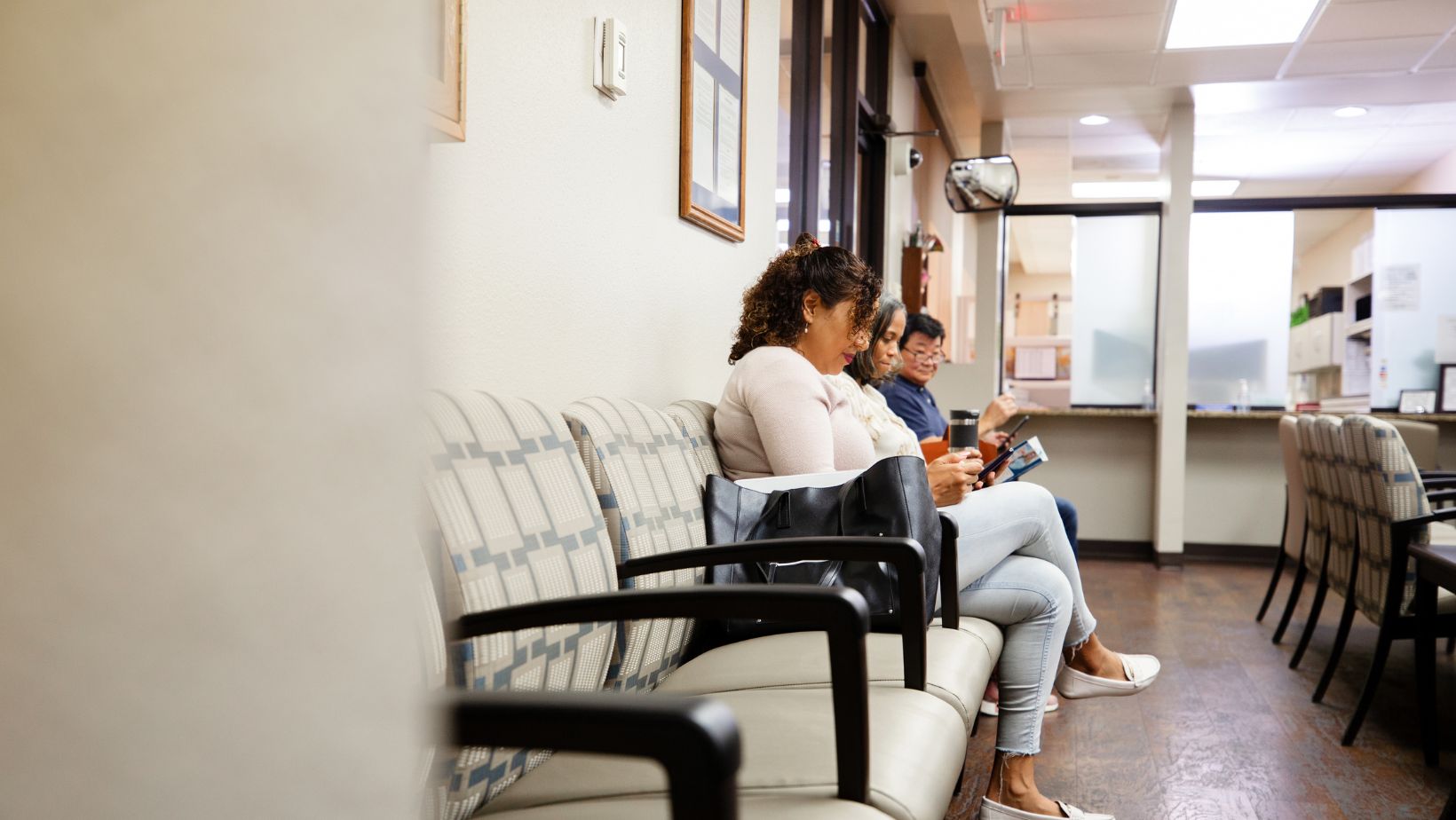You can improve your waiting area comfort without excessive financial investment.
Investing in waiting room chairs represents an important business choice because it influences patient satisfaction levels and staff morale while impacting your financial performance. The UK contract furniture sector’s 2024 valuation of USD 2.72 Billion demonstrates healthcare environments’ commitment to improving seating solutions.
Creating a welcoming and functional waiting area that makes a good impression does not require excessive spending.
What You Need to Know:
- Why Waiting Room Chairs Matter
- Budget-Friendly Upgrade Options
- Smart Selection Strategies
- Maintenance Tips to Extend Chair Lifespan
- Future-Proofing Your Seating Investment
Why Waiting Room Chairs Matter
Waiting room chairs serve as the cornerstone for the patient experience in your waiting area. Think about it: The majority of time patients spend in your facility occurs on your chairs while experiencing feelings of anxiety and discomfort.
Waiting areas are experiencing unprecedented pressure levels according to the Institute for Fiscal Studies. Your seating options must be able to handle growing numbers of patients while maintaining their condition.
But here’s the real kicker…
Poor seating choices can lead to:
- Increased patient complaints
- Negative online reviews
- Higher replacement costs
- Compliance issues with accessibility requirements
By choosing the right waiting room chairs you can convert your space into a competitive benefit instead of a liability.
The best part? Through careful planning and judicious upgrades facilities operating under financial constraints can achieve exceptional improvements in their waiting areas with minimal spending.
Budget-Friendly Upgrade Options
Looking for cost-effective ways to refresh your waiting room chairs without replacing everything? You’ve got more options than you might think.
Reupholstery vs. Replacement
Facility managers often face the major decision of whether to reupholster furniture or to replace it entirely. Here’s what to consider:
- Reupholstery saves 40-60% compared to new chairs while reducing waste in landfills and offering fabric choice customization.
- Replacement benefits include adherence to contemporary design standards and ergonomic updates while offering cost savings for chairs that need significant repair.
In cases where chairs have solid frames yet show worn upholstery a reupholstery process emerges as the most cost-efficient option. Healthcare facilities extend their seating lifespan by five or more years using strategic reupholstery techniques.
Modular Systems
The design of waiting areas has been transformed by modular seating because of its outstanding adaptability. These systems allow you to:
- Reconfigure layouts as needs change
- Replace individual components rather than entire units
- Combine different elements to create unique custom seating configurations
Healthcare facilities increasingly prefer modular designs because they slash reconfiguration expenses drastically.
Hybrid Approaches
Don’t fall into the all-or-nothing trap! Many successful facilities take a hybrid approach:
- Replace high-visibility seating first
- Reupholster serviceable chairs in less prominent areas
- Gradually update in phases as budget allows
This approach delivers instant upgrades by distributing expenses throughout several budget periods.
Bulk Purchasing Power
Never underestimate the power of volume discounts. You will obtain better pricing when you synchronize buying across departments or team up with other healthcare centers.
Bulk orders from some suppliers come with 15-25% discounts which expand the scope of what you can achieve within your budget limitations.
Smart Selection Strategies
Selecting appropriate waiting room chairs requires consideration of several different factors.
Decisions made today based on current market data will set your facility up for enduring prosperity.
Material Matters
The type of material used for waiting room chairs plays a crucial role in determining their lifespan as well as how well they stand up to wear and cleaning demands while supporting infection prevention efforts.
- Vinyl and faux leather chairs provide moderate durability that lasts 5 to 7 years with proper care and feature both easy cleaning and antimicrobial options.

- Healthcare-grade fabrics provide enhanced comfort and the option for antimicrobial treatments but need more maintenance.
- Mesh backing creates better airflow while saving costs and minimizing the area that needs cleaning.
Select a material that meets your facility’s particular requirements. Wipeable surfaces represent a cost-effective solution in areas with high foot traffic and elevated infection risks.
Ergonomics Isn’t Optional
Here’s something many facilities overlook…
Ergonomics serves not only to provide comfort but also to help prevent further health complications in patients who experience existing pain conditions. Key ergonomic features to consider include:
- Most adult users need chairs with seat heights that range from 17 to 19 inches.
- Supportive backrests with proper lumbar support
- Waterfall seat edges help to lessen thigh pressure.
- The design of armrests should include the proper height level and removable options for better accessibility.
Facilities must provide seating solutions that handle increased patient numbers without sacrificing durability or comfort due to waiting lists surpassing 7 million at NHS England.
Specialty Considerations
Various patient groups require unique seating arrangements.
- For bariatric patients healthcare providers need chairs that support weights over 250kg.
- The seating for elderly patients must include higher seat heights along with sturdy armrests to provide necessary support.
- Pediatric areas: Appropriately sized seating, wipeable surfaces
- Mental health settings: Anti-ligature designs, weighted bases
Understanding these varied patient needs is essential since specialized seating helps minimize liability risks while enhancing patient comfort.
Space Optimization
Here’s something that’s often overlooked…
Your chair arrangement affects how many people can be accommodated while also determining patient comfort levels. Keep a minimum of 36-inch pathways for wheelchair access and arrange chairs so they face information points and call screens for patient visibility.
As different departments experience unique growth rates in demand for their specialties, your waiting area configuration should provide for variable wait periods throughout these sections.
Maintenance Tips to Extend Chair Lifespan
How can you maximize the value of your waiting room chairs investment?
Routine maintenance will enable your chairs to operate twice as long transforming a 5-year chair into a durable 10-year model. Maximize your investment returns with this approach.
Regular Inspection Protocol
Develop a systematic approach to chair maintenance:
- Weekly visual inspections: Perform weekly visual checks to identify any clear signs of damage along with loose parts and discoloration.
- Monthly stability tests: Perform stability tests monthly to identify any wobbling or structural defects in each chair.

- Quarterly deep cleaning: Schedule thorough professional cleaning and disinfection
- Bi-annual maintenance day: During bi-annual maintenance days, all fasteners should be tightened, any minor repairs need addressing and materials must be conditioned.
Routine inspections help identify minor issues before they turn into costly repairs. Facility managers report annual savings of thousands of dollars because preventative maintenance reduces the need for reactive replacements.
The Bottom Line
You can update your waiting room chairs without spending large amounts of money. Strategic planning combined with careful material choices and proper maintenance enables significant improvements to your waiting area experience while maintaining budget control.
Remember these key takeaways:
- Prioritize long-term quality investments in key areas.
- When evaluating total cost of ownership examine both maintenance requirements and replacement timelines
- Standardize furniture yet tailor selections to match specific space requirements.
- Maintain diligently: Extend lifespan through proper care
These guidelines will lead to the development of a waiting room that improves patient satisfaction, meets staff requirements and delivers a worthwhile financial return over the years.

